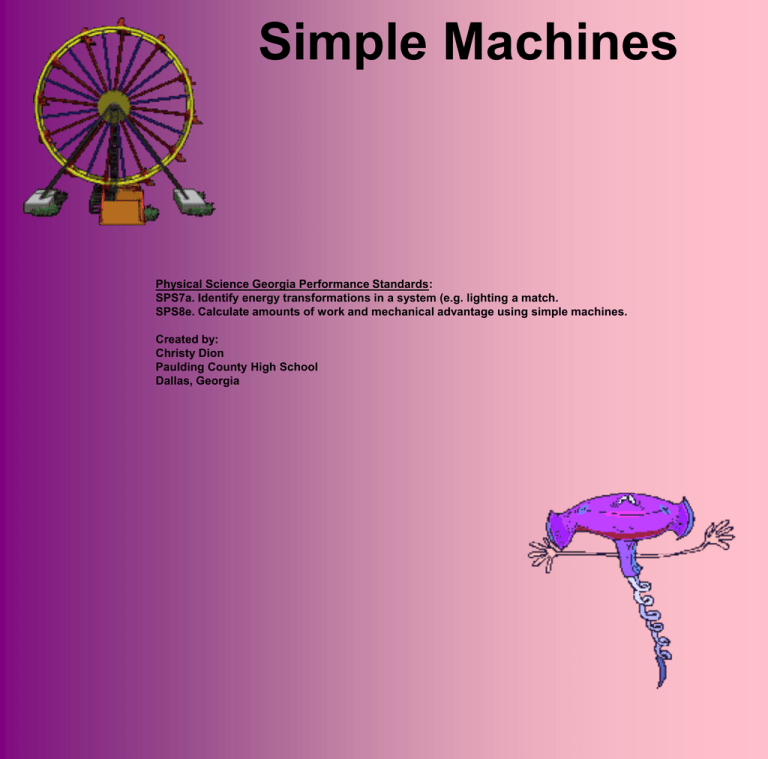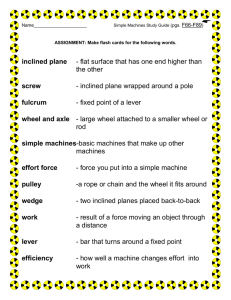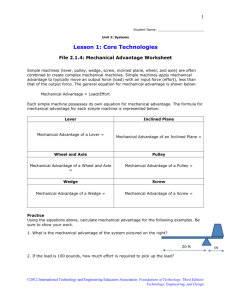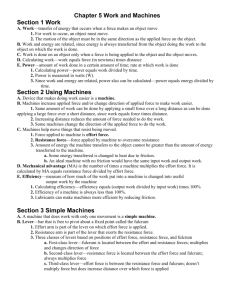Simple Machines - Loudoun County Public Schools
advertisement

Simple Machines Physical Science Georgia Performance Standards: SPS7a. Identify energy transformations in a system (e.g. lighting a match. SPS8e. Calculate amounts of work and mechanical advantage using simple machines. Created by: Christy Dion Paulding County High School Dallas, Georgia What is a simple machine? A simple machine is a machine that does work with only one movement of that machine. There are 6 basic simple machines: 1) Screw 4) Wedge 2) Lever 5) Pulley 3) Inclined Plane 6) Wheel & Axle Levers A Lever is a bar that is free to pivot around a fixed point. There are three types of levers: Levers: what they do... Any tool that pries something loose is a lever. A lever is an arm that pivots (or turns) against a fulcrum (or point). Think of the claw end of a hammer that you use to pry a nail loose. It's a lever. It's a curved arm that rests against a point on a surface. As you rotate the arm it pries the nail from the surface. First Class Lever A see-saw is an example. In a first class lever, the farther away from the fulcrum you apply the force, the easier it is to lift up objects. The closer to the fulcrum you apply the force, the more effort you need to lift up the resistance. The resistance goes in the opposite direction of the effort. If a person pushes down, the resistance goes up, and if a person pushes up, the resistance goes down. Second Class Lever A wheel barrow is an example. A second class lever is a lever in which the resistance is located between the fulcrum and the effort. A second class lever always increases the effort force. The fulcrum is the wheel and resistance in a wheelbarrow is the object being moved while the person pushing the wheelbarrow supplies the effort. Third Class Lever An example is a person's arm. A third class lever always decreases the effort force. The effort is between the resistance and the fulcrum. The fulcrum is the elbow, the biceps provide the resistance and the effort is whatever is being lifted. The distance from the elbow to the biceps is the effort arm and the distance from the elbow to whatever one is trying to lift is the resistance arm. A third class lever is always a disadvantage. Determining Lever Class FLE Rule ·First Class Lever - Fulcrum in the center · ·Second Class Lever- Load in the center · ·Third Class Lever - Effort in the center Use the objects on this page to show each of the levels of levers. Ideal Mechanical Advantage of a Lever The ideal mechanical advantage (IMA) for any simple machine can be calculated by dividing the input distance by the output distance. For a lever, the input distance is the length of the input arm and the output distance is the length of the output arm. length of input arm (m) = length of output arm (m) Ideal Mechanical Advantage Lin IMA = Lout Let's Practice: John uses a lever to lift a weight of 5 N. The input distance (where the input force is applied) is 50 cm. The output distance (where the output force is applied) is 5 cm. What is the ideal mechanical advantage of the lever? IMA = input distance of lever output distance Know Setup Solve Input distance = 50 cm; output distance = 5 cm IMA = IMA = 10 50 cm 5 cm Let's Practice: Howard uses a pulley system to raise a bucket from a well. He pulls his end on the rope 5 m and the bucket is raised 2.5 m. What is the ideal mechanical advantage of this pulley system? IMA= input distance output distance Know Setup Solve Input distance = 5 m; output distance = 2.5 m IMA = IMA = 2 5 cm 2.5 cm Pulleys A pulley is a grooved wheel with a rope, chain, or cable running along a groove. A movable pulley is one where the end of the rope is fixed and the wheel is free to move. A fixed pulley changes only the direction of your force. Ex. flagpole Block & Tackle Pulley A block and tackle pulley consists of movable and fixed pulleys together. The IMA of a pulley system is equal to the number of weight segments that support the weight. Identify the type of pulley below? Click on the flashing images to begin. Wheel & Axle A wheel and axle is a simple machine consisting of a shaft or axle attached to the center of a larger wheel so that the wheel and axle rotate together. The wheel and axle move Ideal Mechanical Advantage of can Wheel and objects Axle: across a distance. IMA = Radius of wheel (m)the axle causing movement. The wheel turns IMA Radius of axle (m) formula rw IMA = ra Let's Practice When making mousetrap cars, wheels are very important, some wheels are larger than others. Pretend one car has the following measurements for their wheels: the radius axle (the small wheel) measured only 1 cm. The radius of the larger wheel (the one that touched the pavement) measured a whopping 10cm. What was the mechanical advantage of these large wheels? Formula: Radius wheel (rw) Radius axle (ra) IMA = 10 cm 1 cm setup IMA = solve IMA = 10* * this means with each turn of the axle you get 10 times the distance Inclined Plane An inclined plane is a sloping surface such as a ramp that reduces the amount of force required to do work. For example a board is a plane, but lying Mechanical Advantage of an Inclined flat on the Plane: ground its not likely to help you do work. IMA = length of slope (m) If slanted it can help you move object height of slope (m) across distances. IM Form IMA= l h Ex. Lifting a heavy box onto a loading dock is easier with a ramp. The Screw If you take an inclined plane and wrap it around a cylinder you get a screw, another simple machine. The IMA of a screw is related to the spacing between the threads. The IMA is larger if the thread are closer together. However, if there are more threads it takes longer to drive the screw into the material. The inclined plane is the threads of the screw. The Wedge A wedge is an inclined plane with one or two sloping sides. It changes the direction of the input force. A knife blade is a wedge, as you cut an apple it pushes the apple halves apart. A wedge is an object that can be used to push objects apart. Let's Practice You got roped into helping your parents' friend move. You are loading some pretty heavy boxes, but luckily they have a ramp on the back of the truck. The truck is 1.5 meters off the ground and the ramp is 6 meters long. What is the IMA of this ramp? IMA = setup solve length of slope height of slope IMA = IMA = 4 6m 1.5m See examples of simple machines in your everyday life at this website! http://edheads.org/activities/simple-machines/ Resources 1) 2) 3) 4) 5) wikipedia.org google images http://www.mswipc.com/problem_sets/mechanical_ad/mechanical_advantage_samples.htm http://www.bristol.k12.ct.us/page.cfm?p=6620 McLaughlin, Thompson, & Zike. "Physical Science." Glencoe Science, McGraw Hill. 2008.







